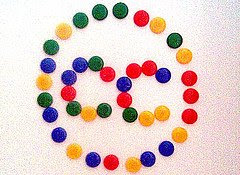 The other day I was training a group of teachers on developing their learners' speaking skills and one of the participants asked me where I got my pictures from and whether this was all on the "up and up."
The other day I was training a group of teachers on developing their learners' speaking skills and one of the participants asked me where I got my pictures from and whether this was all on the "up and up."
It suddenly dawned on me that actually a lot of EFL and ESL teachers, materials authors, newsletter, journal, blog and freebie ELT magazine writers don't actually know about creative commons.
So what is creative commons?
Creative Commons is a type of license that is added to a piece of work (photo, music, video and more) and rather than assign copyright to it the author gives permission for this item to be used by whomever, as long as they appropriately attribute it (put the name of the author).
The simplest way to cross-check against the different sources of creative commons material is here:
http://search.creativecommons.org/
You can also do an advanced search from google, yahoo or directly in flickr, blip.tv, spinXpress.
How can you use it in class?
The sky's the limit.
 I use it to create interesting worksheets, make the cover pages for my commercial worksheets, make games to divide up my training groups, use photos in my blog entries to make them look interesting ;-) LOL, have even used a piece of music as backdrop to my video, etc.
I use it to create interesting worksheets, make the cover pages for my commercial worksheets, make games to divide up my training groups, use photos in my blog entries to make them look interesting ;-) LOL, have even used a piece of music as backdrop to my video, etc.
The bottom line is that you can have as much fun and be as creative as you like.
For free! Of course, it's always a nice idea to give back too and these days I walk about with a camera and have been uploading my own stuff into flickr and of course, my blog entries are CC'd too and institutions or teaching associations are welcome to use them in their magazines.
Can you do anything at all with the stuff you take?
Well, actually there are six different types of creative commons licenses so I generally do an advanced search and specify how I'm going to use something and then go from there.
I also try to make sure that I respect the originality of the work and its creator by letting him/her know when and how I've used something. They always like this ;-).
Anyway, this might seem like a lot to take in so here's a great video explaining it all here:
A longer, more in-depth, video and explanation behind the philosophy and concepts of creative commons can be found here.
For a general reference on the types of licenses, I've cut and paste from Wikipedia as follows:
Attribution Non-commercial No Derivatives (by-nc-nd) This license is the most restrictive of the six main licenses, allowing redistribution. This license is often called the “free advertising” license because it allows others to download your works and share them with others as long as they mention you and link back to you, but they can’t change them in any way or use them commercially.
Attribution Non-commercial Share Alike (by-nc-sa) This license lets others remix, tweak, and build upon your work non-commercially, as long as they credit you and license their new creations under the identical terms. Others can download and redistribute your work just like the by-nc-nd license, but they can also translate, make remixes, and produce new stories based on your work. All new work based on yours will carry the same license, so any derivatives will also be non-commercial in nature.
Attribution Non-commercial (by-nc) This license lets others remix, tweak, and build upon your work non-commercially, and although their new works must also acknowledge you and be non-commercial, they don’t have to license their derivative works on the same terms.
Attribution No Derivatives (by-nd) This license allows for redistribution, commercial and non-commercial, as long as it is passed along unchanged and in whole, with credit to you.
Attribution Share Alike (by-sa) This license lets others remix, tweak, and build upon your work even for commercial reasons, as long as they credit you and license their new creations under the identical terms. This license is often compared to open source software licenses. All new works based on yours will carry the same license, so any derivatives will also allow commercial use.
Attribution (by) This license lets others distribute, remix, tweak, and build upon your work, even commercially, as long as they credit you for the original creation. This is the most accommodating of licenses offered, in terms of what others can do with your works licensed under Attribution.
Best,
Karenne










Thx for the tips. Good article.
Flickr CC retrieves photos by tag word.
Update for those who don't have permission from their schools to view video, here's a great slideshare on the issue:
http://www.slideshare.net/ramblinglibrarian/creative-commons-what-how-why/
Great all round posting on CC Karenne. Will certainly be sending trainees this way in the future.
Thanks
Jamie
Searching at http://search.creativecommons.org/ isn't a way to check if material is licensed under CC. Click on the link "Understand Your Search Results" under the search field and read further. Or read the bold text on the main page "Do not assume that the results displayed in this search portal are under a CC license".
Thanks Chris - that's good to know - I guess get to individual pictures and then check for the license?
How do you do it?
I must admit I have an account with Flickr and then on each search specify that I want cc photos only.
So far I don't use materials I find online. The mishmash of jurisdiction, copyright law, licensing, and terms of use make it almost certain that one is opening themselves up for lawsuits.
Ah, no Chris - they'd be no point at all to creative commons if all people thought like you!
For example, my articles are cc-sa-nc -that means for example that if a teaching association is interested in using one of my pieces, they can (and do).
I went to Legoland last year with my nephew and took a whole bunch of photos of lego animals. I put them in to Flickr so that teachers who have students who are looking for animals + lego can find them and use them. IF I had to receive an email every time that someone wanted to use a photo or an article of mine, I'd get massively bored with that!
For the most part, if you use creative-commons search for a piece of music or whatever media then you read further and check the license on the individual item - not decide to "give" up on using other people's media!
:) CC is about the most amazing thing that could happen to those of us with materials to share, it's our collective intelligence mashed up.
The point to CC has nothing to do with the way I think.
Your cc-sa-nc means I can't use your text as the basis for teaching english in the classes I do as a freelance teacher. I can't make a gap fill out of them, I can't record the text for playback, I can't make photocopies of them. Legally.
So I need to create my own materials. There's a flickr group 'imagestoteachlanguages' where all the material I looked at is copyrighted. The submitters meant to provide a pool for educators to use when teaching languages. Unfortunately that isn't what they achieved.
If I simply use those images to teach english in my classes I'm breaking the law. Again, I need to therefore create my own materials.
So the reality is that CC or no CC material is still imprisoned and not available for remixing. Rather than expose myself to legal hassles, I'll just create my own materials. This has nothing to do with my attitude. Just the reality of the legal world.
Uh-uh, that's not right at all - I really think you've misunderstood the concept - do watch the video again -
in fact cc gives one the complete right to change things - it's just that you need to provide "attribution"!
If you go to the main page of my blog, rather than this article, there's an extra section which deals with copyright and explains my own policy more thoroughly.
It's my complete and express wish that any teacher can use my ideas and lesson plans and blog posts or I'd really be rather wasting my writing this blog and their/your time reading it!!!
If I put a CC-ND (no derivatives) that would say that you could photocopy and share but you couldn't make a gap-fill - in the case of the materials I sell or am going to sell then I do put an ND on those (not generally on my blog...however)
Mostly I use CC-SA-NC.
SA = (share alike) that means you can print off and photocopy and spread as often and in whatever way you would like to
NC means that you can do what you want with them but you can't sell the mashed up new version
I hope this makes it a bit clearer.
By the way, I noticed you're coming down for TechToolsDay and really looking forward to meeting you! Carl Dowse is going to spend some time discussing copyright and creative commons!
K
No I don't think I have misunderstood the concept.
As you may know, I'm a freelance english teacher in germany. If I use your text in a class I teach, that's a commercial use.
I'm not allowed to do this under your license. This is also the case with many of the photos posted on flicker. If I use these images in a class that I get paid to teach, that's a commercial use. I'd be very interested in references you could provide that suggest something to the contrary.
Many people mistakenly believe that they can use materials if they provide attribution. Many others mistakenly believe they can use material as they see fit for educational purposes. Unfortunately, in Germany and many other countries this isn't actually true.
aaah, interesting dilemma... whenever I stamp an NC on something I specifically mean that someone can't repackage my work and then sell it from their own site (you'd be surprised at the amount of shysters there are out there - even bloggers who just take people's work and pass it off as their own... so the protection's about that) definitely not that you (or anyone else) can't use my materials in a class they get paid for...
So - you have my permission to use away in your classes and I'll clarify the copyleft statement in my blog blurb too.
Most images you find on flickr tho' I find, aren't stamped with an NC, so as long as you look for CC signs you should be in the clear!
Ta - for making me think again onn this.
K